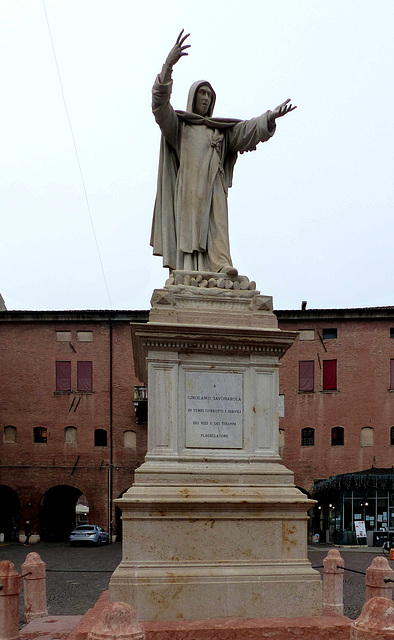Ferrara - Mercato coperto di Santo Stefano
Ferrara - Museo della Cattedrale
Ferrara - Museo della Cattedrale
Ferrara - Museo della Cattedrale
Ferrara - Museo della Cattedrale
Ferrara - Museo della Cattedrale
Ferrara - Museo della Cattedrale
Ferrara - Museo della Cattedrale
Ferrara - Museo della Cattedrale
Ferrara - Museo della Cattedrale
Ferrara - Museo della Cattedrale
Ravenna - Torre Civica
Ravenna - Kiosk
Ravenna - Battistero Neoniano
Ravenna - Battistero Neoniano
Ravenna - Battistero Neoniano
Ravenna - Battistero Neoniano
Ravenna - Chiesa di Santa Giustina
Ravenna - Duomo
Ravenna - Duomo
Ravenna - Museo arcivescovile
Ravenna - Museo arcivescovile
Ravenna - Museo arcivescovile
Ferrara - Cattedrale di San Giorgio
Ferrara - Cattedrale di San Giorgio
Ferrara - Cattedrale di San Giorgio (PiP)
Ferrara - Tabaccheria Garibaldi
Ferrara - Chiesa di San Giuliano
Ferrara - Chiesa di San Giuliano
Ferrara - Poste e Telegrafi
Ferrara - Castello Estense
Ferrara - Castello Estense
Bentivoglio - Municipio
Bologna - Cattedrale Metropolitana di San Pietro
Bologna - Cattedrale Metropolitana di San Pietro
Bologna - Cattedrale Metropolitana di San Pietro
Bologna - Oratorio dello Spirito Santo
Bologna - Basilica di San Martino
Bologna - Basilica di San Francesco
Bologna - Basilica dei SS. Vitale e Agricola
Bologna - Basilica del Sepolcro
Bologna - Basilica dei SS. Vitale e Agricola
Bologna
Bologna - Piazza del Nettuno
Bologna - Piazza Maggiore
Location
Lat, Lng:
Lat, Lng:
You can copy the above to your favourite mapping app.
Address: unknown
Lat, Lng:
You can copy the above to your favourite mapping app.
Address: unknown
Keywords
Authorizations, license
-
Visible by: Everyone -
All rights reserved
-
34 visits
Ferrara - Girolamo Savonarola


Ferrara appears first in a document of the Lombard king Desiderius of 753 when he captured the town from the Exarchate of Ravenna. Later the Franks, after routing the Lombards, presented Ferrara to the Papacy in 754. In 988 Ferrara was ceded by the Church to the House of Canossa, but at the death of Matilda of Tuscany in 1115, it became a free commune. During the 12th century, the history of the town was marked by the wrestling for power between the Guelph Adelardi and the Ghibelline Salinguerra families. The Ghibellines won and in 1264 Obizzo II d'Este was proclaimed lifelong ruler of Ferrara. His rule marked the end of the communal period in Ferrara and the beginning of the Este rule, which lasted until 1598.
Girolamo Savonarola was born here in 1452. He was an Italian Dominican friar and a rebellious preacher active in Renaissance Florence. His flaming speeches against the depravity of the ruling classes were cheered by large sections of the people. In 1495, Pope Alexander VI forbade Savonarola to continue preaching, but soon after he denounced the abuses in the church again. In February 1497, Savonarola had crowds of youths and children ("fanciulli") parade through Florence, confiscating "in the name of Christ" everything that could be interpreted as a symbol of human depravity. This included paintings, jewelry, cosmetics, mirrors, secular musical instruments, playing cards, elaborately crafted furniture, and expensive clothing. In February 1498, all these items were burned on a huge pyre in Piazza della Signoria.
Already in May 1497, Savonarola had been excommunicated by Pope Alexander VI as a "heretic". When the Pope demanded that the magistrate Florence imprison Savavarola an enraged crowd dragged Savonarola from the monastery. He was imprisoned, tortured, and sentenced to death after confessing to the misdeeds with which he was charged. Before his execution, he recanted his confessions, but they falsified his trial record in this regard. Savonarola was finally hanged and then burned with two confreres in front of a huge crowd on 23 May 1498.
Martin Luther considered Savonarola to be a vital precursor to the Reformation.
Girolamo Savonarola was born here in 1452. He was an Italian Dominican friar and a rebellious preacher active in Renaissance Florence. His flaming speeches against the depravity of the ruling classes were cheered by large sections of the people. In 1495, Pope Alexander VI forbade Savonarola to continue preaching, but soon after he denounced the abuses in the church again. In February 1497, Savonarola had crowds of youths and children ("fanciulli") parade through Florence, confiscating "in the name of Christ" everything that could be interpreted as a symbol of human depravity. This included paintings, jewelry, cosmetics, mirrors, secular musical instruments, playing cards, elaborately crafted furniture, and expensive clothing. In February 1498, all these items were burned on a huge pyre in Piazza della Signoria.
Already in May 1497, Savonarola had been excommunicated by Pope Alexander VI as a "heretic". When the Pope demanded that the magistrate Florence imprison Savavarola an enraged crowd dragged Savonarola from the monastery. He was imprisoned, tortured, and sentenced to death after confessing to the misdeeds with which he was charged. Before his execution, he recanted his confessions, but they falsified his trial record in this regard. Savonarola was finally hanged and then burned with two confreres in front of a huge crowd on 23 May 1498.
Martin Luther considered Savonarola to be a vital precursor to the Reformation.
- Keyboard shortcuts:
Jump to top
RSS feed- Latest comments - Subscribe to the comment feeds of this photo
- ipernity © 2007-2024
- Help & Contact
|
Club news
|
About ipernity
|
History |
ipernity Club & Prices |
Guide of good conduct
Donate | Group guidelines | Privacy policy | Terms of use | Statutes | In memoria -
Facebook
Twitter

Sign-in to write a comment.